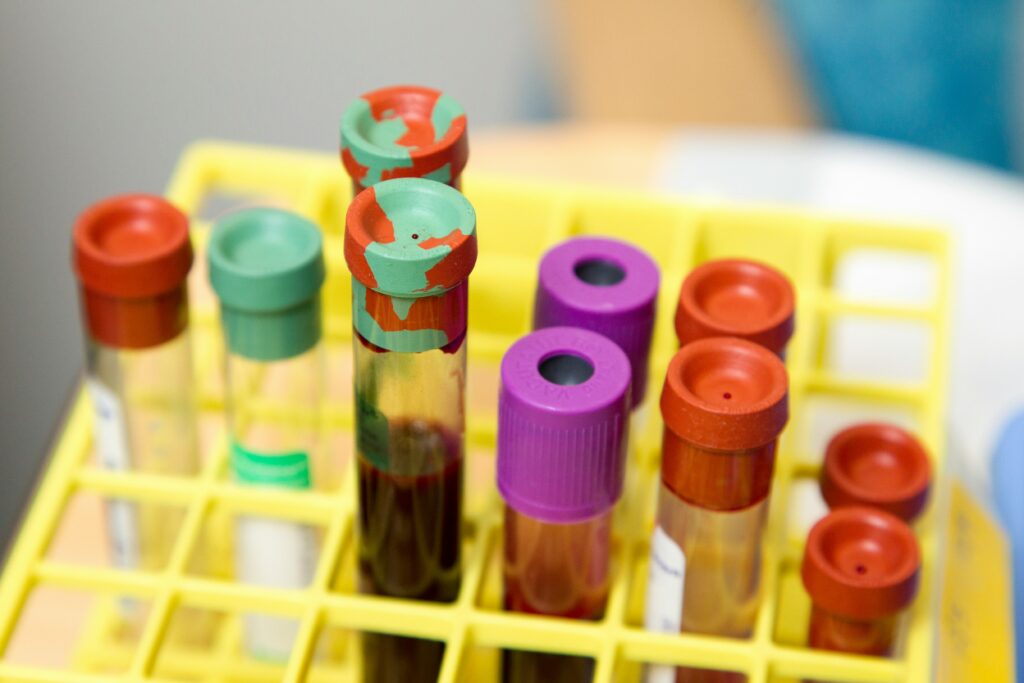
Sex hormone binding globulin (SHBG) is a crucial protein produced primarily in the liver and in smaller quantities in the testes, responsible for carrying hormones like testosterone, dihydrotestosterone, and estradiol throughout the body. Its main role is to regulate the amount of these hormones in the bloodstream and influence which tissues they can reach, affecting both males and females’ health.
A SHBG blood test measures the levels of SHBG, providing insight into various hormonal balance aspects, including high SHBG levels, and is often conducted alongside tests for testosterone to assess an individual’s hormonal health thoroughly. Understanding SHBG levels is vital for diagnosing and managing conditions that affect hormonal balance.
The Role of Sex Hormone Binding Globulin in the Body
Sex hormone binding globulin (SHBG) is not only integral to the transport of sex hormones like testosterone and estradiol but also plays a pivotal role in regulating their availability and function within the body. Primarily produced in the liver, SHBG controls the plasma distribution of these hormones, ensuring they are adequately available where needed without overwhelming the body’s delicate systems. This regulation is crucial for maintaining hormonal balance and supporting overall reproductive health.
Distribution and Regulation of Hormones
- Transport of Sex Hormones: SHBG binds to hormones such as testosterone and estradiol in the bloodstream, which helps transport these molecules to various tissues throughout the body.
- Regulation of Hormone Levels: By binding to these hormones, SHBG controls their bioavailability and activity, preventing excessive hormonal interaction with cellular receptors, which could lead to imbalances.
- Protection of Tissues: SHBG accumulates in specific tissues and regulates how hormones interact with these areas, particularly in the extravascular compartments and the cytoplasm of epithelial cells, where it can influence cellular functions.
Unique Functions Across Species
SHBG exhibits some intriguing roles beyond human physiology. In fish, for example, SHBG functions uniquely in the gill where it acts as a portal not only for natural steroids but also for xenobiotics, including synthetic steroids. This highlights the evolutionary significance of SHBG in different species, adapting to environmental and biological needs by protecting the organism from potentially harmful external substances.
Gene Expression and Hormonal Control
The expression of the SHBG gene is primarily in the liver in mammals, with minor expression noted in other tissues such as the testis. Intriguingly, in humans, SHBG is also produced in germ cells within the testes, where it plays roles in reproductive functions distinct from its hormonal transport activity. Hormonal control of SHBG levels is finely tuned by estrogens and thyroid hormones, which enhance its production, while androgens tend to suppress it. Understanding these mechanisms is crucial for grasping how SHBG levels fluctuate during different life stages, such as the higher levels observed in children before puberty which stabilize into adulthood.
Factors Influencing SHBG Levels
Key Factors Influencing SHBG Levels
Several factors significantly impact SHBG levels in individuals, affecting their health and hormonal balance. Understanding these factors can guide better management strategies and diagnostic approaches.
- Genetic and Biological Factors:
- Sex and Age: Natural variations occur with different sexes and ages. Typically, SHBG levels increase as individuals age.
- Genetic Variations: Genetics play a crucial role in determining baseline SHBG levels, influencing how individuals respond to hormonal changes over their lifetime.
- Physiological and Health Conditions:
- Body Weight and Metabolism: Higher body mass index (BMI) is often associated with lower SHBG levels. This is particularly evident in conditions like obesity and metabolic syndrome.
- Thyroid Health: Thyroid function dramatically affects SHBG concentrations. An overactive thyroid (hyperthyroidism) can increase SHBG levels, whereas an underactive thyroid (hypothyroidism) tends to decrease them.
- Chronic Conditions: Conditions such as type 2 diabetes and polycystic ovary syndrome (PCOS) are known to reduce SHBG levels, which can complicate the management of these diseases.
- Impact of Medications and Lifestyle Choices:
- Medications: The use of certain medications like androgens, estrogens, and glucocorticoids can alter SHBG levels, necessitating adjustments in dosage and treatment plans for affected individuals.
- Lifestyle Factors: Lifestyle choices, including diet and exercise, can also influence SHBG levels, highlighting the importance of holistic approaches in managing health and hormonal balance.
By closely monitoring and understanding these factors, healthcare providers can offer more personalized and effective treatment regimens for their patients, ensuring better health outcomes.
Health Implications of Abnormal SHBG Levels
Impact on Male and Female Health
In Males:
- Low SHBG Levels: May lead to fluid retention, acne, increased appetite and weight gain, increased muscle mass, and mood swings. Excessive testosterone can contribute to erectile dysfunction and enlarged breast tissue.
- High SHBG Levels: Often result in a higher proportion of biologically inactive sex hormones, impacting sexual function, bone health, and muscle mass negatively.
In Females:
- Low SHBG Levels: Can cause weight gain, excess facial and body hair, acne, mood changes, and menstrual irregularities. Elevated estrogen levels may lead to symptoms like irregular periods, mood swings, bloating, and breast tenderness.
- High SHBG Levels: Similar to men, high levels in women may lead to reduced biological activity of sex hormones, influencing bone density and overall hormonal balance.
Associated Health Conditions
Conditions Indicated by Low SHBG Levels:
- Hypothyroidism: Underactive thyroid function can decrease SHBG levels.
- Metabolic Syndrome: Includes obesity, type 2 diabetes, and cardiovascular diseases, often marked by reduced levels of SHBG.
- Polycystic Ovary Syndrome (PCOS): Common in women with low SHBG levels, which may also predict the onset of type 2 diabetes.
Conditions Indicated by High SHBG Levels:
- Liver Disease and Hyperthyroidism: Both conditions can elevate SHBG levels.
- Use of Estrogenic Medications: Such as hormone replacement therapy and birth control pills, particularly in females, can increase SHBG levels.
SHBG Levels and Age-Related Changes
Variations Across Age Groups:
- In Males: SHBG levels generally increase with age, correlating with lower testosterone levels.
- In Females: The impact of aging and menopause on SHBG levels is less defined, requiring further research for clearer understanding.
Specific Population Observations:
- Children with Obesity: Weight loss in obese children is associated with a significant increase in SHBG levels, indicating improved hormonal and metabolic health.
Managing and Testing for SHBG Levels
Understanding the SHBG Blood Test
The SHBG (Sex Hormone Binding Globulin) blood test is a vital diagnostic tool used primarily to measure the levels of SHBG in the blood, which plays a crucial role in binding to sex hormones such as testosterone and estrogen. This test is particularly important when symptoms suggest hormonal imbalances that are not explained by total testosterone levels alone.
When is SHBG Testing Recommended?
- For Men:
- Symptoms such as low sex drive, difficulty achieving an erection, and fertility issues may prompt a healthcare provider to recommend an SHBG test to assess low testosterone levels.
- For Women:
- In cases where there is excessive hair growth, deepening of the voice, irregular menstrual periods, acne, weight gain, and fertility concerns, an SHBG test may be suggested to evaluate high testosterone levels.
- Children and Adolescents:
- High SHBG levels are normal in children, acting as a protective mechanism against premature hormonal effects on body tissues. However, low levels might lead to early puberty, warranting a timely evaluation.
Practical Aspects of SHBG Testing
- Test Administration: The SHBG test is conducted in a medical setting such as a doctor’s office, hospital, or lab. It is not available as an at-home test, ensuring professional handling and accuracy.
- Cost Considerations: The cost of an SHBG test can vary based on factors like the location of the testing facility and whether it is covered by health insurance.
- Frequency of Testing: SHBG testing is not routinely ordered but is considered when there is a discrepancy between total testosterone results and clinical symptoms. This targeted approach helps in pinpointing the underlying issues more accurately.
By integrating SHBG testing into the diagnostic process, healthcare providers can offer more personalized treatment plans, addressing specific hormonal imbalances effectively. This is crucial for managing conditions related to both low and high testosterone levels, enhancing patient care and improving health outcomes.
FAQs
1. Is it advantageous to have higher levels of SHBG?
Higher levels of Sex Hormone Binding Globulin (SHBG) are generally considered beneficial as they are linked to a protective effect against poor metabolic health. Conversely, lower levels of SHBG are associated with an increased risk of cardiovascular diseases, Type 2 Diabetes Mellitus (T2DM), and other related health issues.
2. What factors influence the levels of sex hormone binding globulin?
Several factors can affect SHBG levels. Increased body weight tends to lower SHBG levels regardless of hormonal status or sex. Dietary fat content also plays a role; higher fat intake results in lower SHBG levels, while a low-fat diet can increase SHBG levels. Additionally, SHBG levels are found to be higher in males with compromised lung function compared to those with healthy lungs.
3. What are the implications of having low SHBG?
Low levels of sex hormone-binding globulin (SHBG) are linked to a variety of health concerns, including cardiovascular disease, cancer, polycystic ovarian syndrome (PCOS), arthritis, and liver disease.
4. How can high sex hormone binding globulin be managed?
Managing high SHBG involves maintaining a healthy body weight and ensuring adequate nutritional intake, particularly protein. Being underweight or consuming a diet low in protein can lead to elevated SHBG levels and reduced sex hormone levels.








